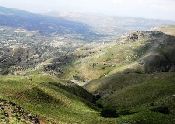|
Desertification can be seen as land degradation in dryland regions. Despite extensive research, lack of good information on the extent and severity of land degradation in drylands still hampers attempts to control it. It is generally accepted that a variety of both natural (climate; biophysical characteristics) and human-induced (land use; socio-economic) factors play a role in the occurrence of land degradation. Also, most scientists agree that participation of local stakeholders (e.g. farmers, local government etc.) is of key importance in the development and implementation of possible solutions. However, often the effects of solutions are not as successful as expected and new, alternative land use and management strategies need to be developed with the experiences of older strategies in mind.
To build upon existing information, DESIRE makes use of the knowledge that has already been gathered in the past. In particular, as much existing information as possible from both within and outside the DESIRE consortium has been assembled in a Review. The review is focused on the Mediterranean area – as is the DESIRE project, but its scope is not exclusively limited to it.
 |
The literature review:
- gives an overview of existing knowledge on desertification from published results of former projects and research;
- assesses the evidence of desertification; and
- indicates gaps in the existing knowledge.
|
|



